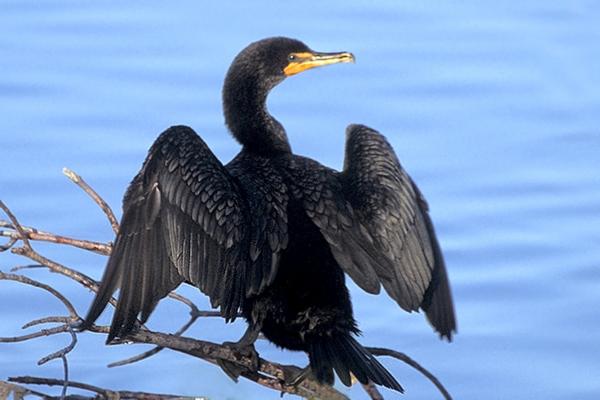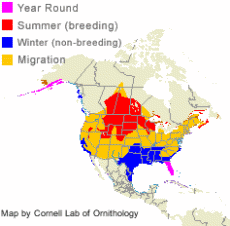 Double-Crested Cormorant Double-Crested CormorantPhalacrocorax auritus
Description
This large water bird has a
wingspan of 45 to 48 inches, a body length of 28
to 35 inches, and a weight of 2½ to 5½ pounds.
It often sits with its wings extended. Both sexes
are similar in plumage and size. Adults are all
black with greenish gloss. During the breeding
season they have small white, black or mottled
plumes over their eyes. Juveniles are much
lighter in color.
 Distribution and Habitat Distribution and Habitat
Double-crested cormorants are
widely distributed across North America. They
breed locally along all coasts, with dense
concentrations being found in Florida, the Great
Plains region, and along the Great Lakes and St.
Lawrence Seaway corridor. Their wintering range
extends along the Pacific Coast from Alaska to
Mexico, along the Atlantic Coast from North
Carolina to Florida, and along the Gulf Coast
from Florida to Belize; they can also be seen in
smaller numbers at inland sites along large
rivers and lakes as far north as Indiana.
These cormorants are found in a
wide variety of aquatic habitats, including
ponds, lakes, rivers, lagoons, estuaries, and
open coastline.
Reproduction
The nest is a large, flat
platform built from sticks, seaweed, and flotsam.
It is not uncommon to find pieces of rope,
deflated balloons, fishnetting, plastic debris,
and other trash among the materials used to
construct the nest. The nest may be located in a
tree, on a cliff, or on the ground.
A typical clutch contains 3 or
4 pale blue eggs. Chicks are naked and helpless
at hatching.
In breeding colonies where the
nests are placed on the ground, young cormorants
(creches) leave their nests and
congregate into groups with other youngsters,
returning to their own nests to be fed.
Diet
Fish make up the majority of
the cormorant's diet, with aquatic insects and
amphibians also being taken on occasion. The
cormorant dives from the surface of the water and
chases its prey underwater, grabbing the prey in
its bill.
Scientific
Classification
phylum Chordata
subphylum Vertebrata
class Aves
order Pelecaniformes
family Phalacrocoracidae
genus & species Phalacrocorax auritus
Questions or comments about
this page?
|



